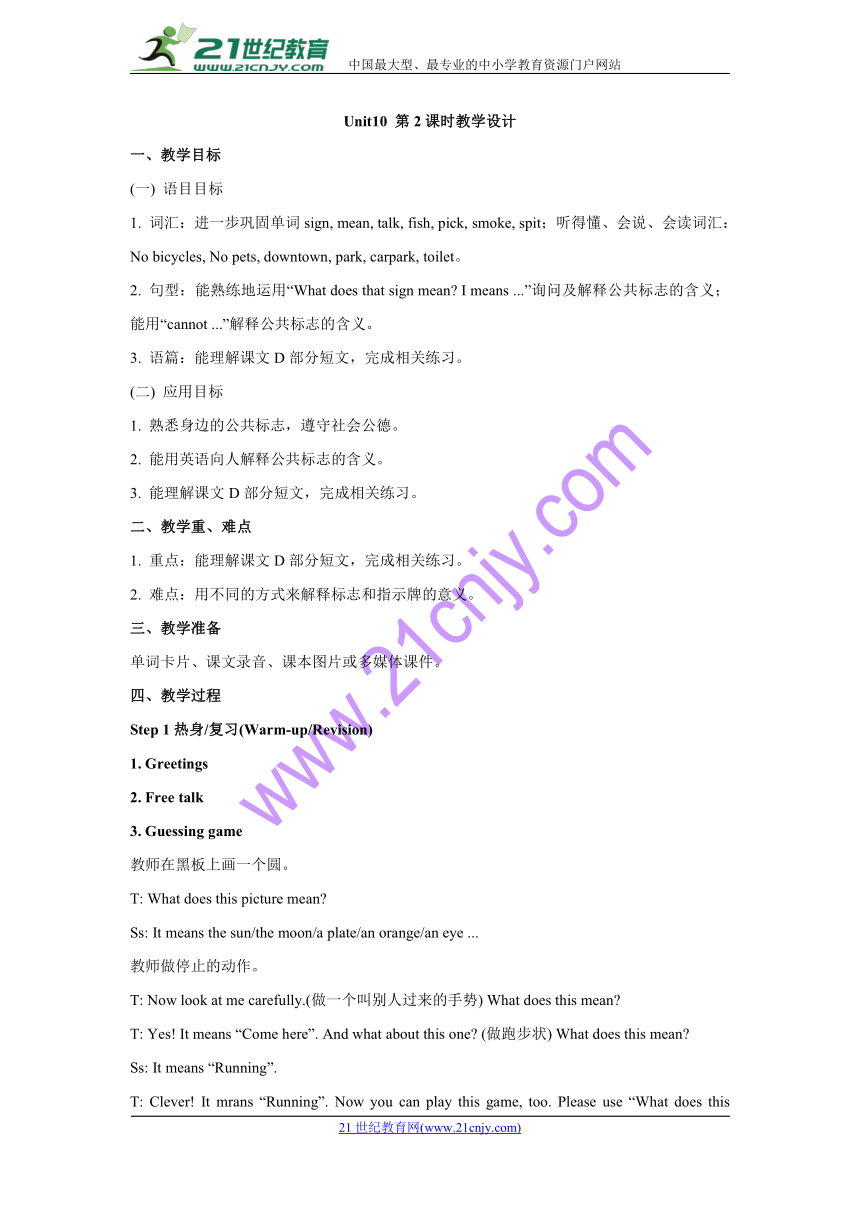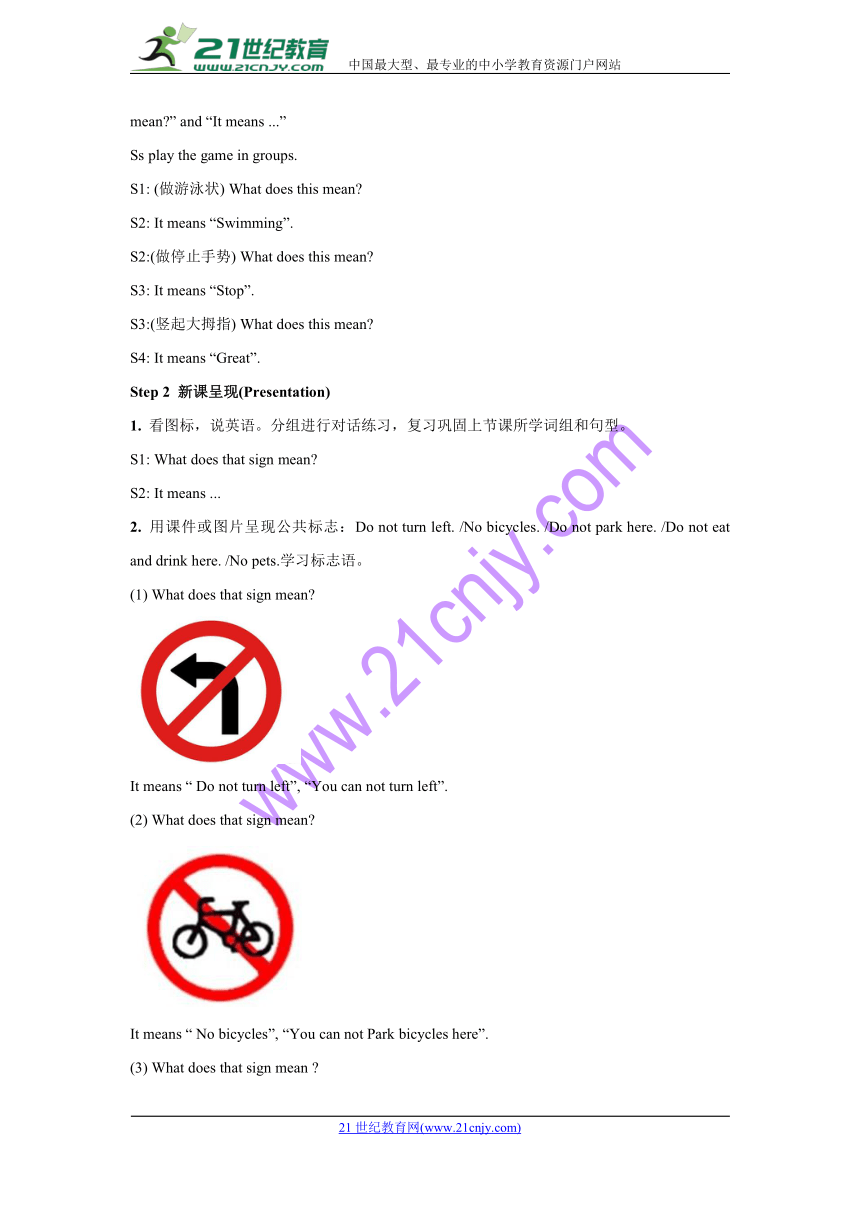Unit 10 What does that sign mean? 第二时教学设计
文档属性
| 名称 | Unit 10 What does that sign mean? 第二时教学设计 |  | |
| 格式 | zip | ||
| 文件大小 | 440.0KB | ||
| 资源类型 | 教案 | ||
| 版本资源 | 湘少版 | ||
| 科目 | 英语 | ||
| 更新时间 | 2018-06-09 18:23:52 | ||
图片预览


文档简介
Unit10 第2课时教学设计
一、教学目标
(一) 语目目标
1. 词汇:进一步巩固单词sign, mean, talk, fish, pick, smoke, spit;听得懂、会说、会读词汇:No bicycles, No pets, downtown, park, carpark, toilet。www.21-cn-jy.com
2. 句型:能熟练地运用“What does that sign mean? I means ...”询问及解释公共标志的含义;能用“cannot ...”解释公共标志的含义。【21cnj*y.co*m】
3. 语篇:能理解课文D部分短文,完成相关练习。
(二) 应用目标
1. 熟悉身边的公共标志,遵守社会公德。
2. 能用英语向人解释公共标志的含义。
3. 能理解课文D部分短文,完成相关练习。
二、教学重、难点
1. 重点:能理解课文D部分短文,完成相关练习。
2. 难点:用不同的方式来解释标志和指示牌的意义。
三、教学准备
单词卡片、课文录音、课本图片或多媒体课件。
四、教学过程
Step 1热身/复习(Warm-up/Revision)
1. Greetings
2. Free talk
3. Guessing game
教师在黑板上画一个圆。
T: What does this picture mean?
Ss: It means the sun/the moon/a plate/an orange/an eye ...21教育网
教师做停止的动作。
T: Now look at me carefully.(做一个叫别人过来的手势) What does this mean?
T: Yes! It means “Come here”. And what about this one? (做跑步状) What does this mean?
Ss: It means “Running”.
T: Clever! It mrans “Running”. Now you can play this game, too. Please use “What does this mean?” and “It means ...”21·cn·jy·com
Ss play the game in groups.
S1: (做游泳状) What does this mean?
S2: It means “Swimming”.
S2:(做停止手势) What does this mean?
S3: It means “Stop”.
S3:(竖起大拇指) What does this mean?
S4: It means “Great”.
Step 2 新课呈现(Presentation)
1. 看图标,说英语。分组进行对话练习,复习巩固上节课所学词组和句型。
S1: What does that sign mean?
S2: It means ...
2. 用课件或图片呈现公共标志:Do not turn left. /No bicycles. /Do not park here. /Do not eat and drink here. /No pets.学习标志语。21·世纪*教育网
(1) What does that sign mean?
It means “ Do not turn left”, “You can not turn left”. 2-1-c-n-j-y
(2) What does that sign mean?
It means “ No bicycles”, “You can not Park bicycles here”. 【21教育名师】
(3) What does that sign mean ?
It means“ No parking”, “You can not park here”
(4) What does that sign mean ?
It means “No eating and drinking here”, “You can not eat and drink here”.
(5)What does that sign mean?
It means “No pets”, “You can not bring your pets here”.2·1·c·n·j·y
3. Let’s practise
完成课文C部分的练习。What does that sign mean? Match the signs with the sentences.
4. 引入D部分短文。用多媒体呈现停车场的场景,学习单词carpark, toilet。
Step 3 阅读拓展(Let’s read)
1. 初读课文,感知语篇。
学生快速阅读课文D部分,了解文章大意。完成下列判断。
Tick or cross.
①It’s Sunday. ( )
②Tim cycles to town with Dino. ( )
③They see three signs. ( )
2. 朗读课文,寻疑索解。
在学生初读课文、了解大意的基础上,教师出示以下表格。
What sign? (图片)
Where?
What does it mean?
T: It is Saturday. Where are Tim and Dino going? Where do they see the sign? What sign is it? What does it mean? Please read the text on your own.21cnjy.com
通过设疑培养学生的寻读能力,让学生根据问题快速浏览课文,有针对性地寻找答案,获取关键信息,培养学生阅读时捕捉文章重要信息的能力。【21·世纪·教育·网】
然后让学生分组完成D部分的True or false练习,帮助学生进一步理解文章内容。
3. 跟读课文,情景交融。
Step 4 趣味练习(Practice)
看照片,为不文明行为配上警示语。
例如:Don’t pick flowers. /No picking flowers.
(展示生活照片,让学生在真实的环境中运用语言,教会学生辨别生活中哪些行为是文明的,哪些是不文明的,遵守社会公德,寓思想教育于语言教学中。)www-2-1-cnjy-com
Step 5 作业布置(Homework)
1. Find out the signs and notices in public.标志、标语大搜索。21*cnjy*com
让学生们课余自己去寻找生活中的标志和标语,不仅能锻炼学生的观察力,激发学生的学习兴趣,也提供了拓展教学的机会。21世纪教育网
2. 抄写B部分的词汇。
一、教学目标
(一) 语目目标
1. 词汇:进一步巩固单词sign, mean, talk, fish, pick, smoke, spit;听得懂、会说、会读词汇:No bicycles, No pets, downtown, park, carpark, toilet。www.21-cn-jy.com
2. 句型:能熟练地运用“What does that sign mean? I means ...”询问及解释公共标志的含义;能用“cannot ...”解释公共标志的含义。【21cnj*y.co*m】
3. 语篇:能理解课文D部分短文,完成相关练习。
(二) 应用目标
1. 熟悉身边的公共标志,遵守社会公德。
2. 能用英语向人解释公共标志的含义。
3. 能理解课文D部分短文,完成相关练习。
二、教学重、难点
1. 重点:能理解课文D部分短文,完成相关练习。
2. 难点:用不同的方式来解释标志和指示牌的意义。
三、教学准备
单词卡片、课文录音、课本图片或多媒体课件。
四、教学过程
Step 1热身/复习(Warm-up/Revision)
1. Greetings
2. Free talk
3. Guessing game
教师在黑板上画一个圆。
T: What does this picture mean?
Ss: It means the sun/the moon/a plate/an orange/an eye ...21教育网
教师做停止的动作。
T: Now look at me carefully.(做一个叫别人过来的手势) What does this mean?
T: Yes! It means “Come here”. And what about this one? (做跑步状) What does this mean?
Ss: It means “Running”.
T: Clever! It mrans “Running”. Now you can play this game, too. Please use “What does this mean?” and “It means ...”21·cn·jy·com
Ss play the game in groups.
S1: (做游泳状) What does this mean?
S2: It means “Swimming”.
S2:(做停止手势) What does this mean?
S3: It means “Stop”.
S3:(竖起大拇指) What does this mean?
S4: It means “Great”.
Step 2 新课呈现(Presentation)
1. 看图标,说英语。分组进行对话练习,复习巩固上节课所学词组和句型。
S1: What does that sign mean?
S2: It means ...
2. 用课件或图片呈现公共标志:Do not turn left. /No bicycles. /Do not park here. /Do not eat and drink here. /No pets.学习标志语。21·世纪*教育网
(1) What does that sign mean?
It means “ Do not turn left”, “You can not turn left”. 2-1-c-n-j-y
(2) What does that sign mean?
It means “ No bicycles”, “You can not Park bicycles here”. 【21教育名师】
(3) What does that sign mean ?
It means“ No parking”, “You can not park here”
(4) What does that sign mean ?
It means “No eating and drinking here”, “You can not eat and drink here”.
(5)What does that sign mean?
It means “No pets”, “You can not bring your pets here”.2·1·c·n·j·y
3. Let’s practise
完成课文C部分的练习。What does that sign mean? Match the signs with the sentences.
4. 引入D部分短文。用多媒体呈现停车场的场景,学习单词carpark, toilet。
Step 3 阅读拓展(Let’s read)
1. 初读课文,感知语篇。
学生快速阅读课文D部分,了解文章大意。完成下列判断。
Tick or cross.
①It’s Sunday. ( )
②Tim cycles to town with Dino. ( )
③They see three signs. ( )
2. 朗读课文,寻疑索解。
在学生初读课文、了解大意的基础上,教师出示以下表格。
What sign? (图片)
Where?
What does it mean?
T: It is Saturday. Where are Tim and Dino going? Where do they see the sign? What sign is it? What does it mean? Please read the text on your own.21cnjy.com
通过设疑培养学生的寻读能力,让学生根据问题快速浏览课文,有针对性地寻找答案,获取关键信息,培养学生阅读时捕捉文章重要信息的能力。【21·世纪·教育·网】
然后让学生分组完成D部分的True or false练习,帮助学生进一步理解文章内容。
3. 跟读课文,情景交融。
Step 4 趣味练习(Practice)
看照片,为不文明行为配上警示语。
例如:Don’t pick flowers. /No picking flowers.
(展示生活照片,让学生在真实的环境中运用语言,教会学生辨别生活中哪些行为是文明的,哪些是不文明的,遵守社会公德,寓思想教育于语言教学中。)www-2-1-cnjy-com
Step 5 作业布置(Homework)
1. Find out the signs and notices in public.标志、标语大搜索。21*cnjy*com
让学生们课余自己去寻找生活中的标志和标语,不仅能锻炼学生的观察力,激发学生的学习兴趣,也提供了拓展教学的机会。21世纪教育网
2. 抄写B部分的词汇。
同课章节目录
- Unit 1 What does she look like?
- Unit 2 I'd like a hamburge
- Unit 3 Do you want some rice?
- Unit 4 Can I use your pencil,please?
- Unit 5 Can I have a pet?
- Unit 6 Which one do you want?
- Unit 7 What time do you get up?
- Unit 8 Lingling helps her parents
- Unit 9 What's your hobby?
- Unit 10 What does that sign mean?
- Unit 11 I'm sorry.
- Unit 12 The Spring Festival
